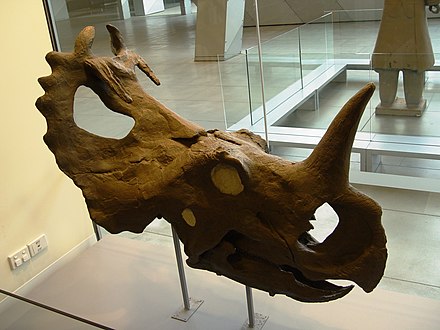Ceratopsia or Ceratopia (/ˌsɛrəˈtɒpsiə/ or /ˌsɛrəˈtoʊpiə/; Greek: "horned faces") is a group of herbivorous, beaked dinosaurs that thrived in what are now North America, Europe, and Asia, during the Cretaceous Period, although ancestral forms lived earlier, in the Jurassic. The earliest known ceratopsian, Yinlong downsi, lived between 161.2 and 155.7 million years ago.[4] The last ceratopsian species, Triceratops prorsus, became extinct during the Cretaceous–Paleogene extinction event, 66 million years ago.[4]
Triceratops is by far the best-known ceratopsian to the general public. It is traditional for ceratopsian genus names to end in "-ceratops", although this is not always the case. One of the first named genera was Ceratops itself, which lent its name to the group, although it is considered a nomen dubium today as its fossil remains have no distinguishing characteristics that are not also found in other ceratopsians.[5][page needed]

Early members of the ceratopsian group, such as Psittacosaurus, were small bipedal animals. Later members, including ceratopsids like Centrosaurus and Triceratops, became very large quadrupeds and developed elaborate facial horns and frills extending over the neck. While these frills might have served to protect the vulnerable neck from predators, they may also have been used for display, thermoregulation, the attachment of large neck and chewing muscles or some combination of the above. Ceratopsians ranged in size from 1 meter (3.3 feet) and 23 kilograms (51 pounds) to over 9 meters (30 feet) and 9,100 kg (20,100 lb).[citation needed]
Ceratopsians are easily recognized by features of the skull. On the tip of a ceratopsian upper jaw is the rostral bone, an edentulous (toothless) ossification, unique to ceratopsians. Othniel Charles Marsh recognized and named this bone, which acts as a mirror image of the predentary bone on the lower jaw. This ossification evolved to morphologically aid the chewing of plant matter.[6] Along with the predentary bone, which forms the tip of the lower jaw in all ornithischians, the rostral forms a superficially parrot-like beak. Also, the jugal bones below the eye are prominent, flaring out sideways to make the skull appear somewhat triangular when viewed from above. This triangular appearance is accentuated in later ceratopsians by the rearwards extension of the parietal and squamosal bones of the skull roof, to form the neck frill.[7][8]

The neck frills of ceratopsids are surrounded by the epoccipital bones.[9] The name is a misnomer, as they are not associated with the occipital bone.[citation needed] Epoccipitals begin as separate bones that fuse during the animal's growth to either the squamosal or parietal bones that make up the base of the frill. These bones were ornamental instead of functional, and may have helped differentiate species. Epoccipitals probably were present in all known ceratopsids.[10] They appear to have been broadly different between short-frilled ceratopsids (centrosaurines) and long-frilled ceratopsids (chasmosaurines), being elliptical with constricted bases in the former group, and triangular with wide bases in the latter group. Within these broad definitions, different species would have somewhat different shapes and numbers. In centrosaurines especially, like Centrosaurus, Pachyrhinosaurus, and Styracosaurus, these bones become long and spike- or hook-like.[8] A well-known example is the coarse sawtooth fringe of broad triangular epoccipitals on the frill of Triceratops. When regarding the ossification's morphogenetic traits, it can be described as dermal. The term epoccipital was coined by paleontologist Othniel Charles Marsh in 1889.[11][12]

The first ceratopsian remains known to science were discovered during the U.S. Geological and Geographical Survey of the Territories led by the American geologist F.V. Hayden. Teeth discovered during an 1855 expedition to Montana were first assigned to hadrosaurids and included within the genus Trachodon. It was not until the early 20th century that some of these were recognized as ceratopsian teeth.[13] During another of Hayden's expeditions in 1872, Fielding Bradford Meek found several giant bones protruding from a hillside in southwestern Wyoming. He alerted paleontologist Edward Drinker Cope, who led a dig to recover the partial skeleton. Cope recognized the remains as a dinosaur, but noted that even though the fossil lacked a skull, it was different from any type of dinosaur then known. He named the new species Agathaumas sylvestris, meaning "marvellous forest-dweller".[14] Soon after, Cope named two more dinosaurs that would eventually come to be recognized as ceratopsids: Polyonax and Monoclonius. Monoclonius was notable for the number of disassociated remains found, including the first evidence of ceratopsid horns and frills. Several Monoclonius fossils were found by Cope, assisted by Charles Hazelius Sternberg, in summer 1876 near the Judith River in Chouteau County, Montana. Since the ceratopsians had not been recognised yet as a distinctive group, Cope was uncertain about much of the fossil material, not recognizing the nasal horn core, nor the brow horns, as part of a fossil horn. The frill bone was interpreted as a part of the breastbone.[15]
In 1888 and 1889, Othniel Charles Marsh described the first well preserved horned dinosaurs, Ceratops and Triceratops. In 1890 Marsh classified them together in the family Ceratopsidae and the order Ceratopsia. This prompted Cope to reexamine his own specimens and to realize that Triceratops, Monoclonius, and Agathaumas all represented a single group of similar dinosaurs, which he named Agathaumidae in 1891. Cope redescribed Monoclonius as a horned dinosaur, with a large nasal horn and two smaller horns over the eyes, and a large frill.



